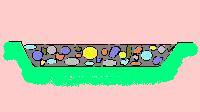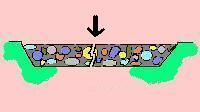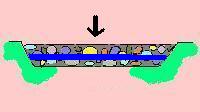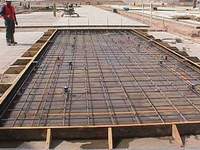CONCRETE STORY 1 (27 march 2004)
If I worked in a prison, wouldn't you expect me to write about criminals, wardens and cells?
Below my apartment, a fitness palace is being built by Cannon's. So every day I am confronted with building noise produced by drilling, hammering, sawing, punching and other operations on concrete .

So wouldn't this be a good opportunity to have a closer look at concrete?
First: what exactly is concrete?
Suppose a farmer has a tractor that he regularly drives to his land.

The chances are great that the tractor will sink into the soft soil, unless this farmer strengthens the soil. Most farmers do this by digging a shallow trench. This trench could be filled with stones or rubble, like this:

But if the farmer filled the trench with only stones, the tractor wouldn't roll on level ground. Besides, the pressure of the wheels would move the stones. This would not provide the firm underground that our farmer wants.
So farmers will often fill up the space between the stones with sand, like this:

If we want to make all movement inside this material impossible, we could glue the sand together. Builders do this with cement . This material (sand, stones and cement) is mixed with water. After some time it will harden. Then we call it concrete.
This concrete can stand great pressure. But if we remove some of the soil under it and exert pressure, it will still break rather easily.

Although the concrete can stand great pressure, it will give way easily if we exert a pulling force. Engineers have discovered they can make concrete resistant to pulling forces by strengthening it with steel rods.

The material above the steel rod (drawn in blue) absorbs pressure. And the steel rod will withstand pulling forces. This combination of concrete and steel is called reinforced steel. It is used in almost every big building these days.
You may have seen the steel rods on building sites.

I admit this weblog was somewhat technical. Still I hope I did not frighten you away. In my next weblog we'll discuss concrete again, but then from a less technical viewpoint.